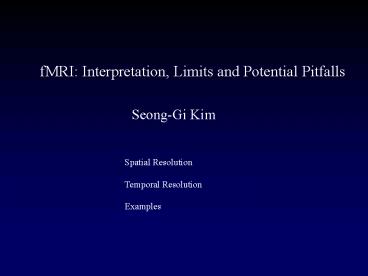CMRR presentation
1 / 39
Title: CMRR presentation
1
fMRI Interpretation, Limits and Potential
Pitfalls
Seong-Gi Kim
Spatial Resolution Temporal Resolution Examples
2
Oxy vs. Deoxy Hemoglobin
Deoxyhemoglobin
Oxyhemoglobin
PARAMAGNETIC
DIAMAGNETIC (Similar toTissue)
3
(No Transcript)
4
Vessel vs. Voxel Size
3 x 3 x 3 mm many vessels, but relatively
uniform vessel distribution (3-5)
Torre et al.
430 µm
5
Spatial Specificity of BOLD Signal to Neural
Activity Site
- Venous Vascular Structures
Pial Venous Vessels 130 380 ?m
diameter Intracortical Veins 80 120 ?m
average diameter 1 2 mm apart
6
Parenchymal Microvessel (lt50 ?m diameter)
Region Blood volume Hct Occipital
cortex 1 33 Corpus callosum 0.4 32 Cer
ebellar nuclei 1.3 34 Systematic
blood 40-45
Rat Fenstermacher et al.
7
Distance between Intracortical Veins
artery
vein
Pia
GM
WM
Distance between emerging venous veins 0.75 - 4
mm
Duvernoy et al. Brain Research Bulletin, 1981
8
Cortical Depth-Dependent High resolution fMRI at
9.4T
(156x 156 µm2 in-resolution, 4-shot EPI, 9.4T)
visual cortex
Coronal
BOLD
T2-weighted, TE20 ms
Zhao et al.
9
Pulse Sequence vs. Susceptibility Effect
Conventional Gradient Echo
STATIC and DYNAMIC Averaging are both detected
(T2)
ACQUIRE DATA
Spin Echo
DYNAMIC Averaging is detected (T2)
ACQUIRE DATA
180 Pulse
10
(No Transcript)
11
Capillary tube (1.4 mm o.d., 1.0 mm i.d.) filled
with blood in a saline bath.
GE
SE
oHb
B0
dHb
B0
dHb
12
Conventional Gradient-echo and Spin-echo BOLD
Signal
CBV 2 ?? 0.1 ppm
Boxerman et al., MRM, 1995
13
Comparison between GE and SE BOLD fMRI at 9.4T
Spin-Echo
Gradient-Echo
Cat 1
Cat 2
Zhao et al.
14
Signal Profiles across the Cortex
Zhao et al.
15
Extravascular and Intravascular BOLD Signal
Contributions
GE SE
Large vessels Small vessels
X X X X
X X X
EV
Large Small
IV
16
BOLD Signals
Dependent on Bo, TE, pulse sequence (GE vs
SE) Dependent on vessel size, orientation, and
density Dependent on hematocrit level Dependent
on oxygenation level
17
Blood-pool Contrast Agent
- - Blood pool contrast agents iron oxides (MION)
- (typical 10 mg Fe/kg body)
- Reduce signals at large vessel areas.
i.v. injection of long half-life contrast agents
Rosen et al., 1991 Mandeville et al., 1998
Kennan et al., 1998
18
fMRI with exogenous contrast agents
Blood pool contrast agents iron oxides (MION)
(typical 10 mg Fe/kg body)
Control
Stimulation
Vessel dilation
(concentration of Fe in a voxel increases)
Fe
Increase susceptibility effect Reduce MRI signals
Rosen et al., 1991 Mandeville et al., 1998
Kennan et al., 1998
19
fMRI without and without MION
(Cat visual stimulation, 156 x156 x 1000 ?m)
(Zhao, Wang, Hendrich, Ugurbil Kim, Neuroimage,
30, 1149-60, 2006)
20
?R2 ?(1/T2) -percent change/TE ?
CBVv(1 Y)
where
1 - Y CMRO2 / CBF
- Cerebral Oxygen Consumption Rate
- Cerebral Blood Flow
- Venous Blood Volume
21
Task/stimulation
Neural activity
CBV
CBF
CMRo2
dHb
T2
T2
22
CBV vs. CBF during Hypercapnia
(?-chloralose anesthetized rats)
rCBV (arbitrary unit)
rCBV 0.975rCBF0.40 (100 CBF -gt 31 CBV)
rCBV 0.31 rCBF 0.67 ( r 0.85 )
58 ml/100 g/min
rCBF (arbitrary unit)
Lee et al., MRM, 2001
23
CBF vs. Arterial and Venous CBV
rCBV (vein)
rCBV (artery)
rCBV (arbitrary unit)
rCBF (arbitrary unit)
Lee et al., MRM, 2001
24
Task/stimulation
Neural activity
CBV
CBF
CMRo2
dHb
T2
T2
25
fMRI Signal Change is related to Neural Activity
LOGOTHETIS et al. Nature, 412, 150 157, 2001
26
Spatial Frequency Dependence
Electrophysiology Recordings
0.15 cyc/deg
A set of six different moving gratings with
spatial frequencies ranging from 0.075 - 0.47
cyc/deg (2 cyc/s) were presented in a
pseudo-random fashion.
Movshon et al., 1978
Harel et al.
27
Spatial Frequency Tuning Curve of BOLD fMRI
28
fMRI Signal Change is related to Neural Activity
LOGOTHETIS et al. Nature, 412, 150 157, 2001
29
Heterogeneity of fMRI changes in humans response
times
(Bilateral finger movements)
Relative Delay Time
2 sec
0 sec
- 2 sec
Provided by P.A. Bandettini
30
Variability in the BOLD Response across subjects
Human V1 Area
BOLD Signal Change ()
Time (seconds)
31
Visual Stimulation under different baseline
conditions
hypercapnia
hypocapnia
n 6 subjects for each study
32
(No Transcript)
33
Interpretation of fMRI signals
- fMRI signal is an index of ensemble of neural
activity - (presumably monotonic relation)
- Neural source of BOLD signal is not clear
spiking activities vs. - synaptic activity, excitatory vs. inhibitory
- Difficulty to compare fMRI signals across
cortical regions and subjects - due to BOLD signal dependencies on vascular
structure and volume.
- Excellent non-invasive tool to map whole brain
functions with relatively high spatial (a few
millimeters in humans) and temporal resolution
(a few seconds).
34
Example 1 Visually-Instructed Four-Finger
Movements
- As soon as a circle is lit, the corresponding
button is pushed. - Tasks, consisting of four finger movements, are
separated by one to several seconds.
Kim et al., Magn Reson Med, 1997
35
(No Transcript)
36
fMRI Signal vs. Finger Movements
finger pressure
Delay time 3 7.5 s
BOLD change ()
37
Example 2 mental rotation experiment
displayed until decision is made
time
Presentation
Contemplation
Decision
Richter et al. J. Cogn. Neurosci, 1999
38
Functional Maps of Mental Rotation
Supplementary Motor Area
Central Sulcus
Superior Parietal Area
Lateral Premotor Area
39
Response Time-locked Time Courses in M1 and SMA
1
Primary motor
Relative fMRI intensity
Supplementary motor
-10
-5
0
5
10
15
Time from button press (sec)































